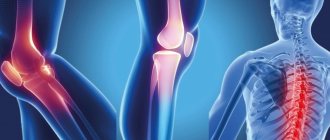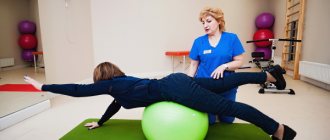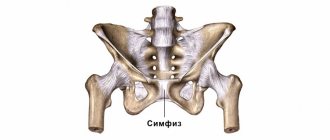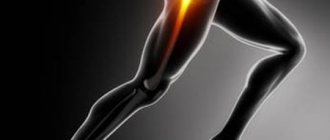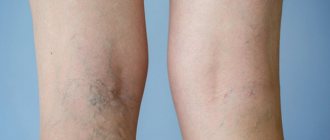Sometimes patients complain of wandering pains throughout the body of varying intensity; they can suddenly appear and disappear regardless of the time of day. There is no such disease in ICD 10; symptoms are usually provoked by various pathologies or disorders that occur in a latent or subacute stage. Often clients come to a traumatologist and ask why their arms and legs are numb, and in such cases a consultation with a neurologist is needed. But migrating muscle pain can be cured by a therapist. Diagnostics will help determine the provoking factor.
Causes of wandering pain
When all the muscles, bones and joints of the whole body hurt, the search for the causes begins with a visit to the doctor. But in order to know which doctor to go to, you need to take into account the presence of chronic diseases, previous infections or a predisposition to the development of various pathologies.
All provoking factors may be common and characteristic of a specific localization of the symptom. Most often, the causes of wandering pain throughout the body are systemic disorders and pathologies:
- physical overload and muscle strain;
- previous acute respiratory viral infections or infectious poisonings;
- postural disorders and spinal diseases;
- muscle inflammation due to hypothermia;
- constant stress and neuroses;
- various chronic diseases (diabetes mellitus, rheumatism, arthritis, etc.).
These are the most common causes of the symptom. It is possible to determine why the muscles of the whole body hurt only by conducting instrumental diagnostics and examination. Before going to the doctor, you need to assume a provoking factor that may cause pain. To do this, you need to take into account its localization and manifestations.
Causes of pain in muscles and joints
Unpleasant symptoms lead to:
- degenerative processes (osteochondrosis, protrusion, disc herniation) and joint inflammation (arthrosis, spondyloarthrosis, spondylolisthesis);
- scoliosis, poor posture, prolonged stay in one position;
- entry of viruses and bacteria into the joint (for example, rubella pathogens);
- autoimmune diseases;
- violation of blood circulation and metabolic processes;
- taking certain medications;
- weakening of the muscle corset;
- stress, shock.
That is, it is not a disease, but a combination of symptoms and causes.
How does it manifest?
Some patients complain of lumbago, acute, aching or constant pain, many note aching bones. In some cases, inflammatory processes are accompanied by high fever and symptoms of intoxication. Weakness and stiffness often occur. Symptoms of muscle and joint pathologies, as a rule, often recur, and the degree of their severity depends on the provoking factor:
- If the pain is caused by damage to muscle fibers, then it is felt in a certain place and intensifies with pressure. It manifests itself more strongly when changing body position and loads.
- Myoarthralgia, provoked by inflammation, leads to night pain that subsides after morning warm-up.
- Degenerative processes are characterized by pain during physical activity, which subsides with rest.
In addition to pain, swelling, swelling of the joints, and numbness of the limbs may occur. Sometimes patients note that discomfort increases with hypothermia and stress.
What is the threat?
Pain in muscles and joints is a dangerous symptom that has many causes; it always requires urgent help from a specialist. Moreover, there is a risk of developing degenerative processes and serious complications of diseases. It is important to start treatment on time to avoid severe consequences and disability. An accurate and timely diagnosis is needed.
Diagnostics
At the initial appointment, the doctor will examine you, assess your condition, complaints, and study your medical history. Based on the data obtained, an examination will be prescribed, which may include diagnostic methods such as:
- Ultrasound and ECG;
- MRI, CT;
- Radiography;
- Laboratory research.
Pain in different parts of the body
Typically, migrating pain throughout the body spreads in a certain area - the right or left limb along the forearm, hand, thigh, lower leg or foot. Synchronicity of lesions on the right and left is often noted; with such severity, a specific disease can be assumed and a preliminary diagnosis can be made. This will help prescribe a course of treatment that will give the most effective results.
You can determine what causes discomfort by location - usually the head, neck, back, stomach or limbs. Certain diseases have an attachment to topography, in which the nature of the pain is different.
In my head
If migrating pain throughout the body is accompanied by the appearance of a symptom in the head, neurological disorders should be assumed. They are caused by exogenous or internal causes:
- Pinched nerves – due to osteochondrosis or muscle spasms, spinal roots can be compressed, which provokes acute stabbing or burning pain;
- With injuries, infections or the initial stage of osteochondrosis, pressing pain in the frontal lobe may appear. In this condition, it is better to be examined immediately; sometimes the symptom is provoked by oncology;
- Often, headaches appear when wearing uncomfortable hats, caps, tight motorcycle helmets, glasses, etc. In such cases, after eliminating the provoking factor, the symptoms completely disappear.
Therapy is selected individually. If pinching is observed, massage, physical therapy, and various physiotherapeutic procedures with skeletal traction are prescribed. If an infection is present, medications are prescribed and must be taken urgently to prevent meningitis.
In muscles and joints
If wandering pain in the joints and muscles occurs, you should visit an orthopedic traumatologist, and if the doctor does not detect any damage, a consultation with a neurologist will be scheduled. The search for the cause is carried out depending on the clinical picture:
- With arthritis, pain can migrate through the joints, affecting the knees, ankles, elbows, and shoulder blades. Depending on the form of the disease, synchronicity or unilateral localization may be observed;
- Injuries or overloads of the limbs - in this case, an analogy can be drawn between pain and the provoking factor: if you often work with your hands, discomfort will be in the hands or forearms, and if you bruise your knees, they will periodically hurt;
- Infections – often intoxication is accompanied by aches and pains in the muscles and joints. In this case, pain will be noted not only in the limbs, but throughout the body;
- Diseases of the spine in the cervicothoracic or lumbosacral regions - if, due to osteochondrosis, hernias or protrusions, the nerves of nearby plexuses are pinched, the pain will spread to the limbs.
In the back and neck
Often wandering pains in the muscles throughout the body appear in the head and neck, here you should immediately assume diseases of the spine or nearby muscles:
- When a nerve is pinched, a stabbing pain usually occurs; when it is compressed, a burning pain occurs. It can be provoked by osteochondrosis, various curvatures, protrusions or hernias. Oncology is less common;
- If myositis is observed, a sharp cutting pain appears and can spread throughout the back. If you have a cold, your temperature may rise, weakness and loss of strength may occur;
- Sometimes muscle spasms develop, which cause severe pain. They usually appear in the presence of previous causes, but can greatly complicate the clinical picture of the disease.
Back and neck pain most often bother people who lead a sedentary lifestyle. When nerves are pinched, the vessels that supply the brain are often compressed. Damage to the vertebral artery, which is located in the transverse processes of the cervical vertebrae, is especially dangerous - then dizziness and headaches appear.
Wandering pain in joints and muscles
A person can feel the main symptoms at night. The problem has several varieties:
- monoarthritis (affects only one joint);
- polyarthritis (when several joints are affected at once).
Characteristic
Wandering pain begins to bother a person due to irritation of the nerve endings or their compression. The cause of the first may be poor circulation or spasm of striated muscles.
Key Features:
- pain most often occurs for a long time (from 3 months or more);
- the nature of the pain is inconsistent, it can be stabbing, aching and sharp;
- pain is asymmetrical.
Reasons for appearance
The condition has several factors, for example, it can be genetics, or an autoimmune reaction (in which the body begins to perceive its cells as foreign and begins to destroy them), as well as the flu along with complications. One of the most common reasons may be stressful situations that negatively affect the body. There may also simply be a lack of vitamins (most often D), calcium and microelements.
When going to the doctor, be sure to tell them whether your relatives have had similar problems.
Factors provoking the disease:
- injuries (fractures, dislocations and sprains);
- heavy loads during sports or work;
- metabolic disease;
- courses of various medications (hormonal, antibiotics and others);
- joint hypermobility;
- dysplasia of connective tissue structures.
Symptoms
As mentioned earlier, symptoms most often appear at night. Wandering joint pain
appears in different parts of the body.
After sleep, a person feels noticeable stiffness in the body. This interferes with leading an active lifestyle, so you should not self-medicate and should immediately consult a doctor. Otherwise, if left inactive for a long time, the joints begin to deform, which leads to disastrous consequences.
The patient experiences elevated body temperature, profuse sweating, lethargy and drowsiness. Pain can appear in completely different places, so it is quite difficult to make an accurate diagnosis.
Stages
A long time passes between the first and last stages, usually from one year to several years.
Initially, the patient does not feel almost any symptoms; stiffness in movements may appear, which is very poorly noticeable. In some cases, swelling and swelling appear, which prevents a person from wearing shoes. You may not even notice the pain, but over time it will become more acute, this means the beginning of the second stage.
Next, the person will feel pain in the hip and other joints. Symptoms can appear at any time of the day. Swelling may appear, as well as a crunching sound when moving. The temperature rises, the skin becomes reddish. Afterwards the pain will become constant. There is a risk of earning disability.
In the last stage, the joint is completely immobilized and there will be constant pain. Moving around will be a challenge for a person. There is a possibility that it will be impossible to heal deformed joints.
If you act in time, you can get rid of the pathology forever. Don't delay treatment.
Diagnostics
First, the patient needs to donate blood for a biochemical analysis. Then be examined by x-ray. It is these simple operations that can give more accurate results than other methods.
If the disease has already taken a severe form, then the sufferer must undergo a course of treatment in a sanatorium.
Prevention
To prevent consequences, you should:
- do not lift or carry heavy objects;
- choose a good mattress and pillow (orthopedic if possible);
- find time to relax in nature;
- give up bad habits (smoking and alcohol);
- harden your body;
- with a sedentary lifestyle, perform exercise routines;
- engage in physical therapy, which involves an even load on all muscle groups.
Treatment methods
joint treatment
should be comprehensive and aimed not only at relieving pain, but also inflammation.
Initially, doctors, as a rule, prescribe light physical activity, mud baths, massage, physical therapy exercises, and the like.
The most effective will be anti-inflammatory drugs, which can only be used with the consent of the attending physician, because they have a sufficient number of contraindications. It is better to use non-steroidal anti-inflammatory drugs. For example, ortofen, indomethacin and others.
If the problem occurs during the cold season, then you should start taking vitamin D, as well as calcium and magnesium.
If the disease has passed the first stage, then you need to take medications that protect the articular cartilage, they prevent complete destruction and act against inflammation. Among folk methods, experts recommend using dandelion root.
If there is no acute pain syndrome, then you can use massage services and do therapeutic exercises.
Traditional methods
These methods are quite good when used in the early stages.
A structure made from a cabbage leaf smeared with honey will help to cope with the pain for a while. It is worth applying it to the sore spot and firmly attaching it with a gauze bandage or towel. It is better to do this before bed and leave it overnight so that the structure does not bother you in the near future.
You can use a variety of decoctions, for example, from strawberries, dandelion, pine, chestnut and other similar plants.
A mixture of kefir and chalk is also suitable; it should be applied to the damaged area and wrapped as in one of the previous methods.
Author: K.M.N., Academician of the Russian Academy of Medical Sciences M.A. Bobyr
